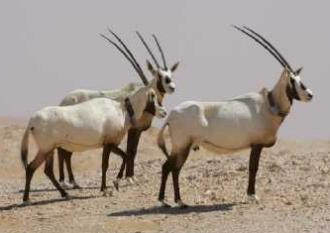 SKC Films Library SKC Films Library |
| SKC Films Library >> Science >> Zoology >> Mammals >> Order Artiodactyla >> Family Bovidae |
| Arabian Oryx Oryx leucoryx Description Well adapted to its desert environment, the Arabian oryx's bright white coat reflects sunlight, and its splayed, shovel-like hooves provide a large surface area with which to walk on the sandy ground. It loses excessive body heat by sweating or by allowing its body temperature to rise higher than of ambient air, which allows the animal to radiate heat to the environment. During this process, the brain is protected from the higher temperatures by cool blood returning from the nasal passages; absorbing heat from warm arterial blood destined for the brain.
The legs are brown, with white bands on the ankles, and there are brown markings on the face, bridge of the nose, and cheeks, as well as a triangular patch on the forehead. Both sexes have straight, ringed horns that can reach over 2 feet in length, with those of the female being thinner and longer than those of the male. The male has a tuft of hair on its throat. The tail of both sexes is tufted at the end and dark brown/black on the lower half. Calves are brown with markings on the tail and knees; they gain their adult markings at about 6 months of age. The Arabian oryx is about 5 feet long, stands up to 3-1/2 feet at the shoulder, and weighs up to 155 pounds. Distribution and Habitat Once widespread on the Arabian Peninsula, reaching north into Israel, Jordan, Iraq, Syria and Sinai in Egypt, the last wild Arabian oryx was shot in 1972 and the species persisted only in captivity for a decade. The rescue of the Arabian oryx began in early 1960s when Fauna and Flora International had the foresight to capture wild oryx and transfer them to Phoenix Zoo in Arizona, and thanks to captive breeding programs wild populations have been re-introduced into protected areas in Israel, Oman and Saudi Arabia. It is generally found on gravel plains, forested savannas, and on the fringes of the desert. Habits and Behaviors The Arabian oryx lives in herds of up to 30 individuals. Herds increase in size in good conditions, but in poor conditions the group size is usually composed of a male, a couple of females and their young; other males are solitary, with large territories. The Arabian oryx can detect rainfall from a great distance. In response to these signals the dominant female will lead a herd in search of the fresh pasture which will have resulted from the rainfall. Noted as a prodigious wanderer in search of pasture, one animal was recorded as walking 58 miles in 18 hours. Most activity occurs in the early morning and late evening with groups resting in the shade during the searing midday heat. Using their front hooves, oryx excavate depressions in the ground, which allows them to lie in cooler sand, and provides some protection against the fierce desert winds. Males use their horns to defend females and territories from other males, and this may result in injury or death. Females also use their horns for protection, for both themselves and their calves. Reproduction Births can occur at any time of the year. A single calf is born after a gestation period of about 9 months. The calf is weaned at about 3-1/2 months, and will reach sexual maturity at 1-1/2 to 2 years. An Arabian oryx can live up to 20 years in the wild. Diet The Arabian oryx feeds on grasses, herbs, roots, and tubers. It can go without direct water sources for long periods of time by drinking dew and fog water that has formed on the plants upon which it feeds. Scientific Classification phylum Chordata SOURCES |
| SKC Films Library >> Science >> Zoology >> Mammals >> Order Artiodactyla
>> Family
Bovidae This page was last updated on June 04, 2017. |
